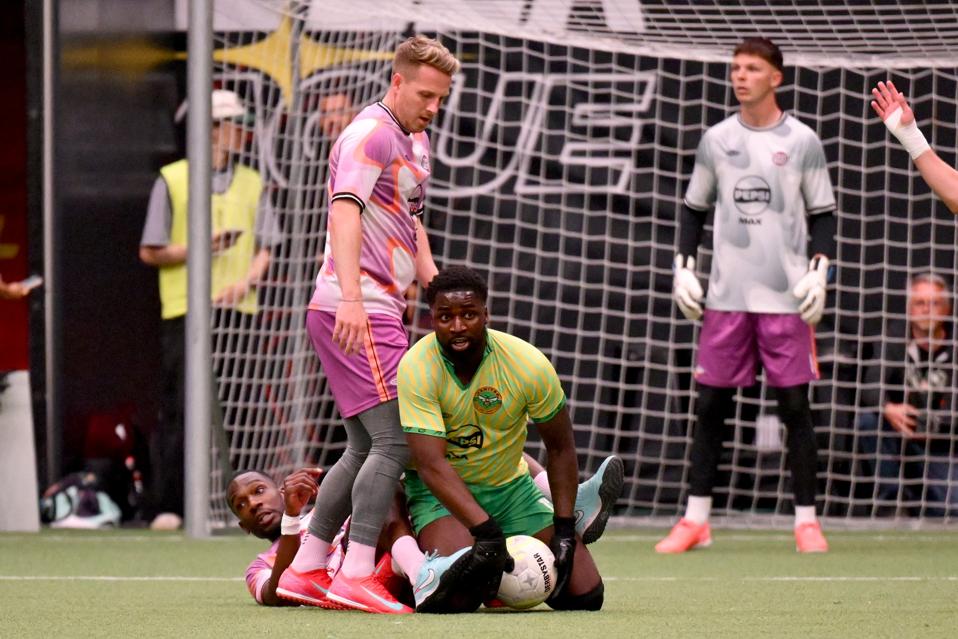A new soccer league took UK social media by storm earlier this year, but rather than multimillion dollar signings and giant stadiums, the Baller League’s players earn in the hundreds of dollars each game and the entire league is played in a 6,000-capacity former handball court in east London.
So how did a six-a-side league of perceived lower-league soccer players become so big it ended up selling out London’s O2 Arena? And how much more can it grow?
“Referring to them as ‘lower league footballers’ is already wrong,” says Baller League CEO Felix Starck. He says most of the players have an academy background and have top-notch technical skills but got cut based on their physical characteristics. Starck says if professional soccer teams came along to the Baller League, they’d probably lose as “It’s a different sport.”
The league does have a few well-known former pros like ex-Premier League striker Troy Deeney, who certainly isn’t lacking on the physical side, but it has also created its own stars like Percy Kiangebeni, also known as PK Humble, whose goal celebration went viral on social media.
“You know what, it weren’t even planned,” said PK Humble who plays for Baller League UK Season 1 semifinalists Yanited, “I’m a vibes man and it reflects on the pitch so it’s become something everyone expects every time I score so it’s basically my signature.”
Before the Baller League, PK Humble had played in English soccer’s sixth tier, but he was better known as a social media influencer for YouTube channels such as The Sidemen or Hashtag United. He says “I saw what they [Baller League]
were building in terms of the energy, the level of football, the way they mix entertainment with the game and I knew this is me.”
Sudeep Ramnani, founder and managing partner of 885 Capital, a sports and technology investment firm backing Baller League, says players like PK Humble “who are not just talented but also able to entertain… have built an audience individually for themselves.”
Ramnani says “I think we’re at an inflection point in sports in general, there’s a lot more disruption than meets the eye.” He says that’s resulted in new business models that are more sponsor-driven or are about leveraging distribution rather than traditional media. When it comes to the Baller League, “It’s not just small-sided football, it’s also about entertainment, it’s about the art of storytelling and it’s about leveraging the decentralized distribution that exists in this world now.”
Baller League’s biggest stars are not on the pitch but in the dugouts. Each of the 12 teams is led by celebrity managers, from ex-pros like John Terry to YouTubers like Miniminter and Yanited’s manager Angryginge.
And those YouTube or Twitch streamers have brought millions of potential viewers to the league and in return have a huge amount of content and exposure for their channels. They’re the ones providing the hype, creating their own narratives and bringing their own styles to attract new fans to the league. Along with high production values, the league also constantly brings in celebrity or influencer guests to keep building awareness.
Ramnani says that while the Baller League had to persuade some big stars to get on board at the beginning, now celebrities and entertainers are very keen to get involved “including many who were previously uninterested in participating”.
While the Premier League derives a large portion of its income from broadcast rights, especially outside the “big six”, and lower league soccer makes its money through people coming through the turnstiles and buying a pie and a coffee at half time, the Baller League is largely reliant on sponsorship revenue.
Ramnani says that rather than advertising getting in the way of consuming a product, “I think what Felix has done amazingly is to bring on board sponsors that create value” through brands closely aligned with soccer and soccer culture such as Pepsi, Nike and protein shake brand Grenade. He says that while other revenue streams might grow in the future, “The goal is eyeballs and delivering value for sponsors initially.”
The match structure makes itself suited to short-form social media content and its 15-minute halves mean people can watch it without it taking up too much of their day. Rule twists at the end of each half such as long-range goals counting double guarantee plenty of late drama such as the Final 4 semifinalists being determined by a buzzer-beater goal in the final regular game day.
With sponsors providing the main revenue channel, the league doesn’t need mass market appeal so long as it’s getting views from the loyal fans of the influencers and YouTubers involved in the league, but it still needs to find ways to maintain interest next season when it’s no longer the hot new thing.
So what’s next for the Baller League? The league, which already runs in Germany and the UK, will launch in the U.S. soon, and Ramnani says “I think Felix is set to win globally” but it has to be done in a sustainable way. He says in some parts of Africa and other places where domestic soccer has not yet met its potential, there are opportunities to surpass even traditional 11-aside soccer.
As for the players, PK Humble says “Yanited is family and it’s given me a different platform to connect with and gain new fans, show my skills, and just have fun doing what I enjoy.”

